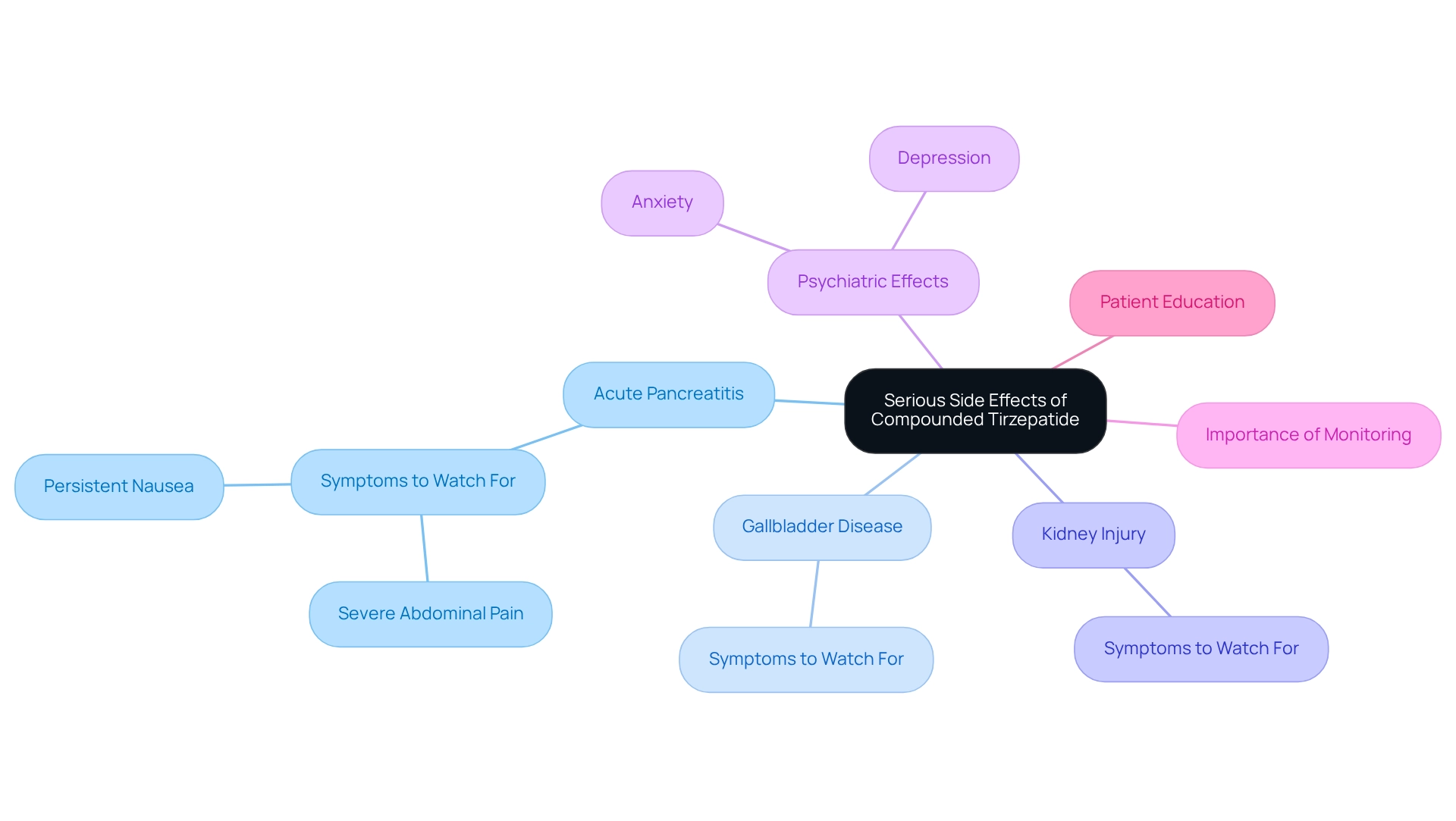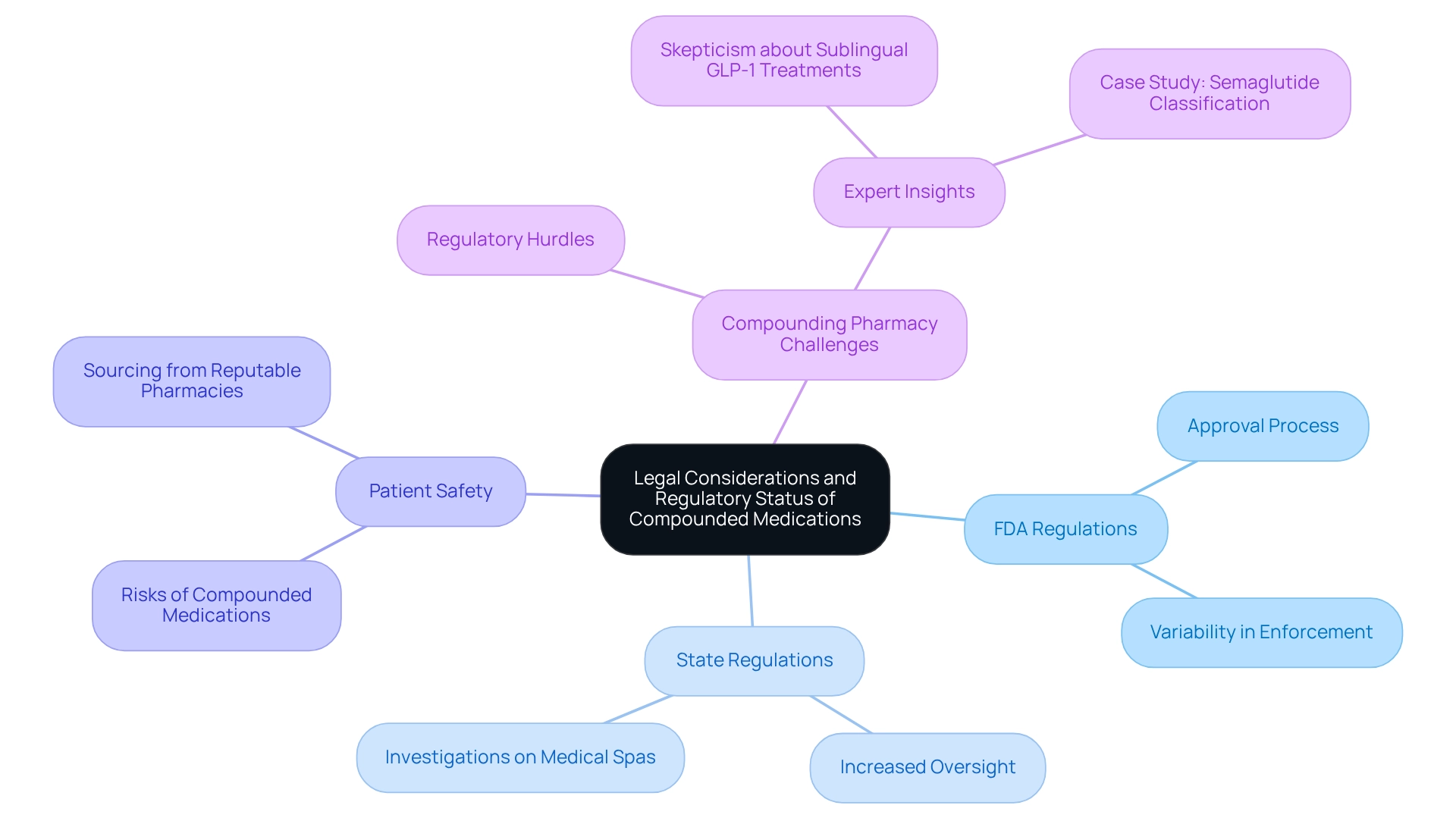Overview
This article aims to shed light on the side effects associated with compounded tirzepatide, a medication designed to help manage type 2 diabetes and support weight loss. We understand that embarking on a weight loss journey can feel overwhelming, and it’s important to be informed. While common side effects may include gastrointestinal issues, there are also serious risks to consider, such as pancreatitis and kidney injury.
Recognizing these potential side effects underscores the importance of personalized care and monitoring. We’re here for you, and it’s crucial to ensure your safety and achieve effective treatment outcomes. By working closely with your healthcare provider, you can navigate these challenges with confidence and support. Together, we can achieve your goals and foster a healthier future.
Introduction
In the journey of managing diabetes and achieving weight loss, compounded tirzepatide stands out as a compassionate option, providing tailored solutions for those seeking effective treatment. Unlike standard medications, this specialized formulation is crafted by licensed compounding pharmacies, allowing for a personalized approach to dosage and delivery that meets each patient’s unique needs.
As compounded medications gain popularity, it’s essential to understand the benefits, potential side effects, and safety profile of tirzepatide. This knowledge empowers you to make informed decisions about your health.
In this article, we will explore the intricacies of compounded tirzepatide, examining its mechanisms, effectiveness, and the vital considerations for patients navigating their health journeys. Together, we can achieve your goals.
What is Compounded Tirzepatide?
Compounded medication offers a specialized formulation of the FDA-approved drug, specifically designed to manage type 2 diabetes and support weight loss. Unlike commercially available options like Mounjaro or Zepbound, these personalized formulations are crafted by licensed compounding pharmacies, allowing for adjustments that cater to individual patient needs. This customization can include variations in dosage and delivery methods, such as injections or oral forms. For those who may not achieve the desired results with standard formulations or require specific dosages that aren’t commercially available, compounded medication can be a comforting choice.
The benefits of formulated medication extend beyond mere personalization. Research shows that GLP-1 receptor agonists, including tirzepatide, are linked to positive changes in lipid profiles, such as significant reductions in triglycerides and modest decreases in LDL cholesterol levels. These improvements play a vital role in overall cardiovascular health, which is especially important for individuals managing obesity and related conditions.
Studies reveal that GLP-1 receptor agonists can significantly lower triglyceride levels, further underscoring their potential in enhancing cardiovascular outcomes.
Furthermore, the rise of customized medications in diabetes treatment reflects a growing recognition of the need for personalized healthcare solutions. Recent statistics indicate that gastrointestinal symptoms are the most common adverse effects experienced by individuals in the first month of treatment. This highlights the importance of personalized care and monitoring for compounded tirzepatide side effects during the early stages of therapy.
Real-life examples showcase the effectiveness of compounded medication in achieving weight loss goals. Many individuals report substantial improvements, reinforcing the importance of a tailored approach to weight management. As Dr. Chance Miller emphasizes, “Clients appreciate the personalized attention from a dedicated care team, which includes physicians like Dr. Chance Miller, who focus on transformative care.” This level of personalized attention is central to Minimal’s commitment to fostering long-term health outcomes.
As the landscape of diabetes and weight loss treatments evolves, compounded medication emerges as a flexible and effective option, bolstered by ongoing research and positive patient outcomes. Together, we can navigate this journey toward better health, ensuring that you feel supported every step of the way.
How Tirzepatide Works
Tirzepatide serves as a dual agonist, targeting both the glucagon-like peptide-1 (GLP-1) and glucose-dependent insulinotropic polypeptide (GIP) receptors. This dual activation is essential for enhancing insulin secretion in response to meals, while also lowering glucagon levels and slowing gastric emptying. These combined effects not only improve blood sugar regulation but also significantly reduce appetite, making this medication an empowering tool for weight loss.
Furthermore, the medication’s dual action aids in regulating energy expenditure, which is vital for overall metabolic health. Recent studies reveal that individuals using this treatment can experience notable weight loss, with many achieving a reduction of up to 20% of their body weight within six months. This statistic underscores the treatment’s effectiveness in real-world scenarios, particularly for those grappling with obesity and related metabolic challenges.
Understanding how this medication works is crucial for recognizing both its potential benefits and the possible side effects associated with tirzepatide. GLP-1 agonists, including this specific medication, have been linked to risks such as pancreatitis and thyroid issues, leading to recommendations against their use in individuals with a history of these conditions. As healthcare providers continue to investigate the implications of GLP-1 and GIP receptor agonists, ongoing research highlights the importance of monitoring individuals for any adverse reactions.
In making decisions about drug classes, expert insights stress the importance of cardiovascular health. As Eric Polley, PhD, shares, “If cardiovascular health is what you think is important for deciding between these drug classes, I think our most recent study provides some strong evidence.” Additionally, the FDA has issued warnings regarding the compounding of Semaglutide formulations, which raises safety concerns that should be taken into account.
For those seeking effective health solutions, Minimal offers a comprehensive weight loss prescription program that integrates personalized treatments, fitness, and nutrition guidance, starting as low as $49 for the first month. This holistic approach not only informs treatment decisions but also empowers individuals on their journey to better health, enhancing their overall well-being. Together, we can achieve your goals and create a healthier future.
Common Side Effects of Compounded Tirzepatide
The side effects of compounded tirzepatide often involve gastrointestinal issues, such as nausea, diarrhea, vomiting, and decreased appetite. Many individuals experience these effects, especially during the early stages of treatment. Notably, severe gastrointestinal side effects are more common in those undergoing this therapy compared to those receiving a placebo.
While these symptoms are typically mild and tend to lessen as your body adjusts to the medication, they can still impact your experience. At Minimal, we recognize that managing these side effects is essential for maintaining your commitment to the treatment plan. Our holistic wellness approach includes personalized weight loss solutions, supported by our dedicated care team of physicians and nutritionists.
In addition to gastrointestinal disturbances, compounded tirzepatide side effects may also include abdominal pain, fatigue, and occasional headaches. We encourage you to monitor your reactions closely and reach out to your healthcare provider if you notice any persistent or severe symptoms.
Expert opinions highlight the importance of proactive management strategies for gastrointestinal issues linked to compounded tirzepatide side effects. Our healthcare providers at Minimal recommend gradual dosage adjustments and dietary changes to help alleviate these reactions. Dr. Chance Miller shares, “Clients appreciate the personalized attention from a dedicated care team, which includes physicians like myself, who emphasize transformative care.” By addressing side effects early and integrating customized fitness and nutrition plans, along with services like breathwork and acupuncture, you can enhance your overall treatment experience and improve your chances of achieving successful weight loss outcomes.
Our weight loss program starts with a consultation to assess your health and determine the best treatment plan, including potential prescription options like Semaglutide. According to data from over 70,000 individuals who have participated in Minimal’s programs for at least six months, many clients experience significant weight loss, reinforcing the effectiveness of the treatment despite potential side effects. Remember, together, we can achieve your goals.
Serious Side Effects to Watch For
While most compounded tirzepatide side effects are typically mild, it’s important to recognize the significant serious effects that individuals should be aware of. These include:
- Acute pancreatitis
- Gallbladder disease
- Kidney injury
If you experience severe abdominal pain, persistent nausea, or significant changes in urine output, it’s crucial to seek immediate medical attention.
In some rare cases, users have reported psychiatric effects such as anxiety and depression. This highlights the importance of monitoring for serious side effects. Medical professionals emphasize the need to inform individuals about these risks and the necessity of regular check-ups with healthcare providers. Dr. Melvin George, a Clinical Research Consultant, reminds us that “individual education and monitoring are crucial to guarantee safety and effectiveness during treatment.”
Taking a proactive approach not only aids in the early detection of potential complications but also ensures that patients feel supported throughout their treatment journey.
Compounded tirzepatide is typically injected once a week, administered in the upper arm, thigh, or stomach. This convenient once-weekly injection combines two drugs to improve blood sugar regulation and helps with weight loss by curbing appetite. Remember to store the medications according to your healthcare provider’s instructions to ensure their safety and efficacy.
Recent studies have highlighted the occurrence rates of acute pancreatitis associated with GLP-1 drugs, including similar treatments. A comprehensive analysis revealed that while the overall risk remains low, vigilance is essential, especially for individuals with pre-existing conditions. In clinical trials, adverse events were reported more frequently in the treatment group, primarily gastrointestinal issues, although these were mostly mild to moderate in severity.
In a case study assessing the impacts of the drug on body composition, participants experienced a notable average decrease in total body fat mass of 33.9% compared to an 8.2% reduction in the placebo group. However, the study also stressed the importance of monitoring for adverse effects, reinforcing the need for a balanced approach to treatment.
Patients using compounded tirzepatide should be well-informed about the symptoms that indicate the need for immediate medical attention. This knowledge empowers you to act swiftly if side effects arise. By understanding potential risks and engaging regularly with healthcare providers, you position yourself for a safer and more effective treatment experience tailored to your specific health goals. Together, we can ensure that your treatment aligns with your health needs and aspirations.
Safety Profile of Compounded Tirzepatide
The safety profile of the formulated medication is vital for both those receiving care and the dedicated healthcare professionals involved. Many individuals report tolerating the treatment well, yet the absence of FDA endorsement for mixed formulations raises valid concerns about quality management and consistency. Unlike commercially available drugs, customized formulations may not undergo the same rigorous testing processes, which could lead to variations in strength and cleanliness.
It’s important to note that approximately 22.50% of healthcare workers have received training specifically on compounding substances. This statistic highlights a knowledge gap that could impact safety for individuals. At Minimal, we address this gap by providing extensive education and support to our healthcare providers, ensuring they are well-equipped to manage complex medications safely. Moreover, case studies have shown that improper mixing practices can result in serious public health issues, such as antimicrobial resistance. This underscores the necessity for strict quality control measures—something we emphasize in our comprehensive approach to healthcare.
We believe that individuals should only utilize the medication under the guidance of a qualified healthcare provider. This oversight is crucial for monitoring potential adverse effects and ensuring appropriate dosing, which ultimately safeguards individual health and enhances treatment efficacy. Real-world evaluations of mixed drug quality control further highlight the importance of collaboration among pharmacists, physicians, and nurses. At Minimal, we actively support this model to ensure safe and effective patient care. Together, we can navigate these complexities and achieve the best outcomes for everyone involved.
Legal Considerations and Regulatory Status
Compounded medication operates within a complex legal framework that can often leave patients feeling uncertain. While the FDA has authorized the use of this medication for specific medical purposes, altered formulations do not receive the same level of approval and oversight. Compounding pharmacies must adhere to both state and federal regulations, but the variability in enforcement can lead to significant discrepancies in product quality.
This inconsistency raises valid concerns about the safety and efficacy of mixed medications, especially when it comes to compounded tirzepatide side effects. As a patient seeking tirzepatide, prioritizing your health means sourcing prescriptions from reputable pharmacies that strictly follow established legal standards. This diligence is essential in reducing the risks associated with unregulated products, particularly the potential adverse health outcomes linked to compounded tirzepatide side effects.
Additionally, ongoing discussions about the classification of semaglutide as overly challenging to compound highlight the precarious position of compounding pharmacies as they navigate regulatory hurdles while striving to meet patient needs. As noted in a recent case study, the FDA has yet to finalize a list of drugs deemed too difficult to prepare, which places compounding pharmacies in a difficult situation.
Expert insights from Adam Gilden, MD, MSCE, shed light on the complexities of obesity medicine and the critical role of custom formulations in patient care. He reminds us that while combined options may present alternatives, the effectiveness of sublingual GLP-1 treatments is still under scrutiny, with experts voicing skepticism about their intended efficacy. Moreover, certain states are focusing their inquiries on medical spas and IV infusion clinics that offer customized weight-loss treatments, with California considering increased oversight.
As the FDA continues to evaluate its stance on compounded therapies, the implications for patients relying on these alternatives are significant. It’s crucial to stay informed and make empowered decisions about your healthcare options. Remember, we’re here for you, and together, we can navigate these challenges to find the best solutions for your health journey.
Drug Interactions: What You Need to Know
Compounded substances have the potential to interact with various drugs, which can modify their effectiveness or increase the risk of negative effects. A significant concern arises when this drug is used alongside insulin or other diabetes treatments, as this combination can heighten the likelihood of hypoglycemia. In fact, data indicates that occurrences of hypoglycemia are notably higher in individuals using this medication with insulin, necessitating careful monitoring and management.
Moreover, medications that affect gastric emptying may also interact with the treatment, potentially influencing its absorption and overall effectiveness. This interaction can lead to unpredictable therapeutic outcomes, making it essential for patients to maintain open communication with their healthcare providers about all medications they are taking, including over-the-counter drugs and dietary supplements.
Healthcare professionals stress the importance of this dialogue. As Dr. Chance Miller notes, “Clients appreciate the personalized attention from a dedicated care team, which includes physicians who emphasize transformative care.”
This personalized approach is vital in effectively managing potential drug interactions.
Patients should be aware of specific drug interactions related to compounded tirzepatide side effects when using compounded medications. For instance, the safety and effectiveness of this medication in conjunction with other weight management products have not been completely confirmed, highlighting the need for caution. Additionally, recent reports have indicated a higher frequency of cholecystitis in the treatment groups compared to placebo, although the overall incidence remains low.
Real-world examples underscore the significance of managing these interactions in diabetes treatment. By ensuring that all treatments are reviewed and monitored, healthcare providers can help reduce risks and enhance the effectiveness of this therapy, ultimately supporting better health outcomes for patients. Notably, with a dropout rate estimated at 25%, ongoing support and adherence to the treatment plan are essential for success.
This aligns with Minimal’s holistic approach, which emphasizes personalized care and continuous engagement. Compounded tirzepatide side effects are important to consider, as this medication is typically injected once a week in the upper arm, thigh, or stomach, making it a convenient option for those seeking weight loss. It merges two drugs for improved blood sugar management and assists with weight reduction by curbing appetite, lowering insulin resistance, and enhancing glucose levels.
Patients should inject the treatment on the same day each week and store it according to their healthcare provider’s instructions. This comprehensive support reinforces the effectiveness of Minimal’s care model.
Key Takeaways on Compounded Tirzepatide
Compounded medication offers a personalized approach to weight management and diabetes control, but it’s important for patients to consider several key factors. Understanding the potential side effects of compounded tirzepatide, along with the medication’s safety profile and legal status, is crucial for making informed decisions. Regular monitoring by healthcare providers is essential to ensure safe usage and effectively manage any potential drug interactions.
Statistics reveal that adverse events related to compounded medication have been reported, with over 320 cases documented. Notably, the third quarter of 2023 saw the highest reporting times for adverse events, with 5,450 reports (27.19%). This underscores the importance of remaining vigilant during treatment. Healthcare professionals also stress the need for ongoing patient education about the treatment process.
A recent assessment highlighted that while this medication offers significant long-term health benefits, its cost-effectiveness remains a concern at current prices. Dr. Jennifer H. Hwang noted, “This economic analysis revealed that although this drug and semaglutide delivered considerable long-term health benefits, they were not cost-effective at current net prices.”
Clinical trials, such as the SURPASS-5 trial, have demonstrated that this medication can lead to significant weight loss, with reductions of up to 10.5 kg observed in participants. These results emphasize the treatment’s potential effectiveness when used appropriately. It is vital to remember that this medication is approved solely for individuals with type 2 diabetes, a critical point for understanding its intended use and limitations.
By incorporating insights from healthcare professionals, individuals are encouraged to engage in open conversations about their treatment options. This ensures they are well-informed about the benefits and risks associated with compounded medication. Additionally, the FDA has received reports of adverse events related to compounded semaglutide and tirzepatide, suggesting that many compounded tirzepatide side effects may be underreported due to federal law not requiring certain pharmacies to submit these reports. By grasping these essential considerations, patients can make empowered choices on their journey toward achieving their health goals.
Conclusion
Compounded tirzepatide emerges as a significant option for those seeking personalized solutions in managing type 2 diabetes and weight loss. This specialized formulation allows for tailored dosages and delivery methods, catering to the unique needs of each patient. By enhancing insulin secretion and aiding in appetite suppression, tirzepatide not only promotes substantial weight loss but also supports improved metabolic health. However, it’s essential to be aware of both common and serious side effects—especially gastrointestinal issues and the potential for more severe reactions—when considering this treatment.
The safety profile of compounded tirzepatide underscores the importance of sourcing medications from reputable pharmacies and maintaining open communication with healthcare providers. Regular monitoring and patient education are vital components of successful treatment, ensuring that any adverse effects or drug interactions are managed proactively. As the landscape of diabetes and weight management continues to evolve, the need for informed decision-making becomes paramount.
Ultimately, compounded tirzepatide represents a promising avenue for achieving health goals, but it requires a comprehensive understanding of its implications. Engaging with healthcare professionals and staying informed about the medication’s benefits and risks empowers you to navigate your treatment journey effectively, leading to safer and more effective outcomes. As interest in personalized medicine grows, compounded tirzepatide stands out as a flexible option that prioritizes individual health needs and fosters long-term wellness. Together, we can achieve your goals and support your journey toward better health.
Frequently Asked Questions
What is compounded medication and how does it relate to diabetes management and weight loss?
Compounded medication offers a specialized formulation of FDA-approved drugs tailored to manage type 2 diabetes and support weight loss. Unlike standard options, these personalized formulations are created by licensed compounding pharmacies, allowing for adjustments based on individual patient needs, including variations in dosage and delivery methods.
What are the benefits of using compounded medication for diabetes and weight loss?
Compounded medication provides personalized treatment that can lead to significant health improvements, such as better lipid profiles, including reduced triglycerides and LDL cholesterol levels. This is particularly beneficial for cardiovascular health, especially in individuals managing obesity and related conditions.
What are GLP-1 receptor agonists and how do they work?
GLP-1 receptor agonists, including tirzepatide, target both GLP-1 and GIP receptors, enhancing insulin secretion, lowering glucagon levels, and slowing gastric emptying. This dual action improves blood sugar regulation and significantly reduces appetite, making it effective for weight loss.
What kind of weight loss results can individuals expect with tirzepatide?
Individuals using tirzepatide can experience notable weight loss, with many achieving reductions of up to 20% of their body weight within six months, demonstrating its effectiveness for those dealing with obesity and metabolic challenges.
What potential side effects are associated with GLP-1 receptor agonists like tirzepatide?
Potential side effects of GLP-1 receptor agonists include risks such as pancreatitis and thyroid issues. Therefore, they are not recommended for individuals with a history of these conditions, and ongoing monitoring for adverse reactions is essential.
How does cardiovascular health factor into the use of GLP-1 receptor agonists?
Cardiovascular health is an important consideration when choosing drug classes for diabetes treatment. Research indicates that GLP-1 receptor agonists can have positive effects on cardiovascular health, which should be taken into account during treatment decisions.
What is the role of Minimal in providing weight loss solutions?
Minimal offers a comprehensive weight loss prescription program that includes personalized treatments, fitness, and nutrition guidance, starting as low as $49 for the first month. This holistic approach supports individuals on their journey to better health and empowers them to achieve their goals.




















